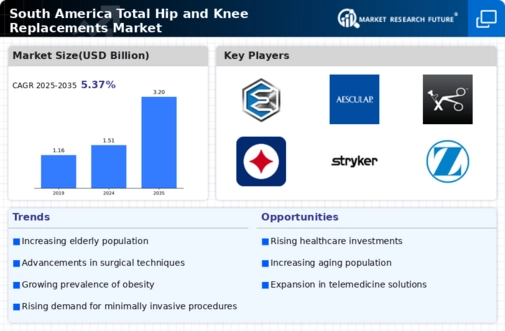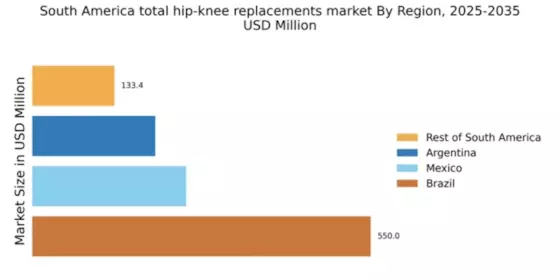Rising Healthcare Expenditure
In South America, rising healthcare expenditure is a crucial factor influencing the total hip-knee-replacements market. Governments and private sectors are increasingly investing in healthcare infrastructure, which enhances access to advanced surgical procedures. For instance, countries like Brazil and Argentina have reported healthcare spending growth rates of around 8% annually. This increase in funding allows for the procurement of state-of-the-art medical technologies and improved surgical facilities, thereby facilitating more hip and knee replacement surgeries. The total hip-knee-replacements market stands to benefit from this trend, as enhanced healthcare access is likely to lead to a higher volume of procedures performed.
Growing Awareness of Joint Health
There is a growing awareness of joint health among the South American population, which is positively impacting the total hip-knee-replacements market. Educational campaigns and health initiatives are increasingly informing individuals about the importance of maintaining joint health and the available treatment options for joint disorders. This heightened awareness is leading to earlier diagnosis and treatment, resulting in a greater number of patients opting for surgical interventions. The total hip-knee-replacements market is likely to see a surge in demand as more individuals recognize the benefits of timely surgical procedures, potentially increasing the market size by 20% over the next five years.
Advancements in Surgical Techniques
Advancements in surgical techniques are significantly shaping the total hip-knee-replacements market in South America. Innovations such as robotic-assisted surgeries and improved implant designs are enhancing surgical outcomes and reducing recovery times. These advancements not only improve patient satisfaction but also encourage more individuals to consider surgery as a viable option for joint pain relief. The total hip-knee-replacements market is expected to expand as these cutting-edge techniques become more widely adopted across hospitals and surgical centers, potentially leading to a 15% increase in procedures performed annually.
Increased Availability of Implants and Prosthetics
The increased availability of implants and prosthetics is a vital driver for the total hip-knee-replacements market in South America. With numerous manufacturers entering the market, there is a wider range of options available for both surgeons and patients. This competition is likely to lead to lower prices and improved quality of implants, making surgeries more accessible. Furthermore, local production of implants is on the rise, which may reduce costs associated with importation. The total hip-knee-replacements market could see a significant boost in procedure rates as affordability and accessibility improve, potentially increasing the market by 25% in the coming years.
Aging Population and Increased Incidence of Joint Disorders
The aging population in South America is a primary driver for the total hip-knee-replacements market. As individuals age, the prevalence of joint disorders such as osteoarthritis and rheumatoid arthritis tends to increase. This demographic shift is significant, with projections indicating that by 2030, approximately 15% of the population in South America will be over 65 years old. Consequently, the demand for total hip and knee replacements is expected to rise, as older adults seek relief from chronic pain and improved mobility. The total hip-knee-replacements market is likely to experience substantial growth, with estimates suggesting a market value increase of over $1 billion by 2027, driven by this demographic trend.


















Leave a Comment